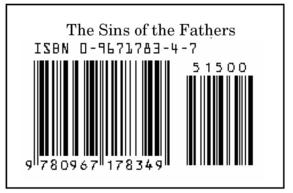A mistake I made in the first several years of FoxAcre Press was to actually put the price on the cover of the book, and embed the price in the barcode. I am now engaged in replacing the covers of various titles to correct this mistake.
Here’s what’s involved and why it matters.
Have a look at these two low-res images of the old and new barcode for the FoxAcre Press edition of Stanley Schmidt’s The Sins of the Fathers.. The real barcodes on the actual book are much higher resolution, but I am using lower-res images here to save storage space and loading time.


Old one is on top, or first, or on the left, depending on the size of the screen you’re using to view this. We’ll say old on left, new on right. Work it out. Note the old one shows a shorter 10-digit ISBN on the top, but that both show the same 13-digit ISBN on the bottom. This involves murky numbering rules and error-checking systems which have updated over the years. Ignore this. Doesn’t matter. The title of the book on the first line, and the box around the whole image, were inserted by me in the layout. Everything else — the rows of digits over the bars, the bars, and the row of digits below, were produced by a barcode-generating program.
Each sequence of thin and wide bars is equivalent to a digit, 0 through 9. The whole point of a barcode is that it is easier for a machine to read the sequence of lines that for it to read numerals, which might be in any of a zillion fonts, and in many of which, for example, the letters O and l might resemble the numerals 0 and 1. The strings of numerals are embedded there just for humans to be able to easily read what the barcodes themselves say.
Note the string that reads 51500 on the left and 90000 on the right. This is the price code. The leading “5” on the left is the equivalent of saying Price Shown in US Dollars. Other leading digits are used for other currencies. The rest of the string on the left tells us the price, with a decimal place assumed after the second digit, so 51500 means USD $15.00. The bars under those numbers also embed the price. Having the price baked into the code is very handy for booksellers that use scanners to manage sales and so on.
Therein lies the problem. If I ever want to change my price, I have to go and change the cover image that contains the barcode — but all the copies I have in stock prior to the change have the old price. Hence the version on the right. Note the digits “90000” in place of 51500. This string basically means “no price shown” and is a placeholder in lieu of the price.
This is, in some circumstances, very slightly inconvenient for the booksellers. It means they might have to key in the price once, by hand, when they enter the price into their bookselling database. It also means the shopper won’t see the price on the back of the book. (If I’m not going to put the price in the barcode in case of a future price change, I’m not going to print the cover price in human-readable characters, either.)
This means that either that the bookseller is going to have to put a pricing label on the book or some such, or that the shopper is going to have to go up to the sales register and ask “How much is this book?”
Now, putting a label on the book or posting the price on the shelf is a nuisance for the bookseller (as is peeling a label off later is a nuisance for the reader) and anything that discourages the shopper — such as not knowing the price — is a bad thing that will reduce sales, at least to some small degree. However, 99%-plus of sales of FoxAcre Press print titles occur online, either direct through the FoxAcre website, or via Amazon or Barnes & Noble or whoever. In those sales, the shopper will never even see the back cover, let alone the barcode on the back cover, and the price will be display on the webpage displaying the item, and can be updated by editing data online, without altering the book-printing files. Balancing the advantages and disadvantages, a publisher in my situation is going to lean toward not including prices either in human-readable or barcode form on the cover.